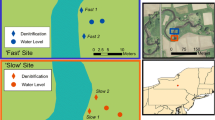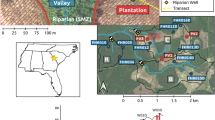Abstract
A better understanding of nitrate removal mechanisms is important for managing the water quality function of stream riparian zones. We examined the linkages between hydrologic flow paths, patterns of electron donors and acceptors and the importance of denitrification as a nitrate removal mechanism in eight riparian zones on glacial till and outwash landscapes in southern Ontario, Canada. Nitrate-N concentrations in shallow groundwater from adjacent cropland declined from levels that were often 10–30 mg L−1 near the field-riparian edge to < 1 mg L−1 in the riparian zones throughout the year. Chloride data suggest that dilution cannot account for most of this nitrate decline. Despite contrasting hydrogeologic settings, these riparian zones displayed a well-organized pattern of electron donors and acceptors that resulted from the transport of oxic nitrate-rich groundwater to portions of the riparian zones where low DO concentrations and an increase in DOC concentrations were encountered. The natural abundances of d15N and in situ acetylene injection to piezometers indicate that denitrification is the primary mechanism of nitrate removal in all of the riparian zones. Our data indicate that effective nitrate removal by denitrification occurs in riparian zones with hydric soils as well as in non-hydric riparian zones and that a shallow water table is not always necessary for efficient nitrate removal by denitrification. The location of 'hot spots' of denitrification within riparian areas can be explained by the influence of key landscape variables such as slope, sediment texture and depth of confining layers on hydrologic pathways that link supplies of electron donors and acceptors.
Similar content being viewed by others
References
Altman S.J. and Parizek R.R. 1995. Dilution of nonpoint-source nitrate in groundwater. J. Environ. Qual. 24: 707–718.
Ambus P. and Lowrance R. 1991. Comparison of denitrification in two riparian soils. Soil Sci. Soc. Am. J. 55: 994–997.
Blicher-Mathiesen G. and Hoffman C.C. 1999. Denitrification as a sink for dissolved nitrous oxide in a freshwater riparian fen. J. Environ. Qual. 28: 257–262.
Bohlke J.K. and Denver J.M. 1995. Combined use of groundwater dating, chemical, and isotopic ana-lyses to resolve the history and fate of nitrate contamination in two agricultural watersheds, Atlantic coastal plain, Marylands. Water Resour. Res. 31: 2319–2339.
Bottcher J., Strebel O., Voerkelius S. and Schmidt H.L. 1990. Using isotope fractionation of nitrate nitrogen and nitrate oxygen for evaluation of microbial denitrification in a sandy aquifer. J. Hydrol. 114: 413–424.
Bragan R.J., Starr J.L. and Parkin T.B. 1997. Shallow groundwater denitrification rate measurement by acetylene block. J. Environ. Qual. 26: 1531–1538.
Burt T.P., Matchett L.S., Goulding K.W.T., Webster C.P. and Haycock N.E. 1999. Denitrification in riparian buffer zones: the role of floodplain sediments. Hydrol. Process. 13: 1451–1463.
Burt T.P., Pinay G., Matheson F.E., Haycock N.E., Butturini A., Clement J.C., Danielescu S., Dowrick D.J., Hefting M.M., Hillbricht-Ilkowska A. et al. 2002. Water table fluctuations in the riparian zone: comparative results from a pan-European experiment. J. Hydrol. 265: 129–148.
Cey E.E., Rudolph D.L., Aravena R. and Parkin G. 1999. Role of the riparian zone in controlling the distribution and fate of agricultural nitrogen near a small stream in southern Ontario. J. Contam. Hydrol. 37: 45–67.
Clement J.C., Pinay G. and Marmonier P. 2002. Seasonal dynamics of denitrification along topohy-drosequences in three different riparian wetlands. J. Environ. Qual. 31: 1025–1037.
Cooper A.B. 1990. Nitrate depletion in the riparian zone and stream channel of a small headwater catchment. Hydrobiology 202: 13–26.
Correll D.L. 1997. Buffer zones and water quality protection: general principles. In: Haycock N.E., Burt T.P., Goulding K.W.T. and Pinay G. (eds) Buffer Zones: Their Processes and Potential in Water Protection. Quest Environmental, pp. 7–20.
Devito K.J. and Hill A.R. 1997. Sulphate dynamics in relation to groundwater–surface water interactions in headwaters wetlands of the Southern Canadian Shield. Hydrol. Process. 11: 485–500.
Devito K.J., Fitzgerald D., Hill A.R. and Aravena R. 2000. Nitrate dynamics in relation to lithology and hydrologic flow path in a river riparian zone. J. Environ. Qual. 29: 1075–1084.
Dhondt K., Boeckx P., Van Cleemput O., Hofman G. and De Troch F. 2002. Seasonal groundwater nitrate dynamics in a riparian buffer zone. Agronomie 22: 747–753.
Dosskey M.G. 2001. Toward quantifying water pollution abatement in response to installing buffers on crop land. Environ. Manage. 28: 577–598.
Environment Canada 1979. Analytical Methods Manual. Inland Water Directorate Water Quality Branch, Ottawa, Canada.
Freeze R.A. and Cherry J.A. 1979. Groundwater. Prentice-Hall, Englewood Cliffs, N.J.
Gillham R.W. and Cherry J.A. 1978. Field evidence of denitrification in shallow groundwater flow systems. Water Pollut. Res. Can. 13: 53–71.
Gilliam J.W. 1994. Riparian wetlands and water quality. J. Environ. Qual. 23: 896–900.
Gilliam J.W., Parsons J.E. and Mikkelsen R.L. 1997. Nitrogen dynamics and buffer zones. In: Haycock N.E., Burt T.P., Goulding K.W.T. and Pinay G. (eds) Buffer Zones: Their Processes and Potential in Water Protection. Quest Environmental, pp. 54–61.
Gold A.J., Jacinthe P.A., Groffman P.M., Wright W.R. and Puffer R.H. 1998. Patchiness in groundwater nitrate removal in a riparian forest. J. Environ. Qual. 27: 146–155.
Gold A.J., Groffman P.M., Addy K., Kellog D.Q., Stolt M. and Rosenblatt M.A.E. 2001. Landscape attributes as controls on ground water nitrate removal capacity of riparian zones. J. Am. Water Resour. Assoc. 37: 1457–1464.
Groffman P.M. 1994. Denitrification in freshwater wetlands. Curr. Topics Wetland Biogeochem. 1: 15–35.
Groffman P.M., Gold A.J. and Simmons R.C. 1992. Nitrate dynamics in riparian forests: microbial studies. J. Environ. Qual. 21: 666–671.
Haycock N.E. and Burt T.P. 1993. Role of floodplain sediments in reducing the nitrate concentration of subsurface run-off. A case study in the Cotswolds, UK. Hydrol. Process. 7: 287–295.
Haycock N.E. and Pinay G. 1993. Groundwater nitrate dynamics in grass and poplar vegetated riparian buffer strips during the winter. J. Environ. Qual. 22: 273–278.
Haycock N.E., Pinay G. and Walker C. 1993. Nitrogen retention in river corridors: European perspec-tives. Ambio 22: 340–346.
Hedin L.O., Von Fischer J.C., Ostrom N.E., Kennedy B.P., Brown M.G. and Robertson G.P. 1998. Thermodynamic constraints on nitrogen transformations and other biogeochemical processes at soil– stream interfaces. Ecology 79: 684–703.
Hill A.R. 1996. Nitrate removal in stream riparian zones. J. Environ. Qual. 25: 743–755.
Hill A.R., Devito K., Campagnolo S. and Sanmugadas K. 2000. Subsurface denitrification in a forested riparian zone; interactions between hydrology and supplies of nitrate and organic carbon. Bio-geochemistry 51: 193–223.
Hill A.R., Vidon P. and Langat J. 2004. Denitrification potential in relation to lithology in five headwater riparian zones. J. Environ. Qual. 33: 799–804.
Hoffman C.C., Rysgaard S. and Berg P. 2000. Denitrification rates predicted by nitrogen-15 labeled nitrate microcosm studies, in situ measurements, and modeling. J. Environ. Qual. 29: 2020–2028.
Jacinthe P.A., Groffman P.M., Gold A.J. and Mosier A. 1998. Patchiness in microbial nitrogen trans-formations in groundwater in a riparian forest. J. Environ. Qual. 27: 156–164.
Jordan T.E., Correll D.L. and Weller D.E. 1993. Nutrient interception by a riparian forest receiving inputs from adjacent cropland. J. Environ. Qual. 22: 467–473.
Karr J.D., Showers W.J., Gilliam J.W. and Andres A.S. 2001. Tracing nitrate transport and environmental impact from intensive swine farming using delta nitrogen-15. J. Environ. Qual. 30: 1163–1175.
Kendall C. and Aravena R. 2000. Nitrate isotopes in groundwater systems. In: Cook P.G. and Herczeg A.L. (eds) Environmental Tracers in Subsurface Hydrology. Kluwer Academic Publishers, Boston, pp. 261–297.
Korom S.F. 1992. Natural denitrification in the saturated zone: a review. Water Resour. Res. 28: 1657–1668.
Lensi R. and Chalamet A. 1982. Denitrification in waterlogged soils: in situ temperature-dependent variations. Soil Biol. Biochem. 14: 51–55.
Lowrance R. 1992. Groundwater nitrate and denitrification in a coastal riparian forest. J. Environ. Qual. 21: 401–405.
Lowrance R., Newbold J.D., Schnabel R.R., Groffman P.M., Denver J.M., Correll D.L., Gilliam J.W., Robinson J.L., Brinsfield R.B., Staver K.S., Lucas W. and Todd A.H. 1997. Water quality functions of riparian forest buffers in Chesapeake Bay watersheds. Environ. Manage. 21: 687–712.
Mariotti A. 1986. Denitrification in groundwaters, principles and methods for its identification: a review. J. Hydrol. 88: 1–23.
Martin T.L., Kaushik N.K., Trevors J.T. and Whiteley H.R. 1999. Review: denitrification in temperate climate riparian zones. Water Air Soil Pollut. 111: 171–186.
McCLain M.E., Boyer E.W., Dent C.L., Gergel S.E., Grimm N.B., Groffman P.M., Hart S.C., Mcdowell W.H. and Pinay G. 2003. Biogeochemical hot spots and hot moments at the interface of terrestrial and aquatic ecosystems. Ecosystems 6: 301–312.
Mengis M., Schiff S.L., Harris M., English M.C., Aravena R., Elgood R.J. and MacLean A. 1999. Multiple geochemical and isotopic approaches for assessing ground water NO1/4ñêôœ`3 elimination in a riparian zone. Ground Water 37: 448–457.
Peterjohn W.T. and Correll D.L. 1984. Nutrient dynamics in an agricultural watershed: observations on the role of a riparian forest. Ecology 65: 1466–1475.
Pinay G., Rogues L. and Fabre A. 1993. Spatial and temporal patterns of denitrification in a riparian forest. J. Appl. Ecol. 30: 581–591.
Roulet N.T. 1990. Hydrology of a headwater basin wetland: groundwater discharge and wetland maintenance. Hydrol. Process. 4: 387–400.
Sabater S., Butturini A., Clement J., Burt T., Dowrick D., Hefting M., Maitre V., Pinay G., Postolache C., Rzepecki M. and Sabater F. 2003. Nitrogen removal by riparian buffers along a European climatic gradient: patterns and factors of variation. Ecosystems 6: 20–30.
Schnabel R.R., Cornish L.F., Stout W.L. and Shaffer J.A. 1996. Denitrification in a grassed and wooded, valley and ridge, riparian ecotone. J. Environ. Qual. 25: 1230–1235.
Simmons R.C., Gold A.J. and Groffman P.M. 1992. Nitrate dynamics in riparian forests: groundwater studies. J. Environ. Qual. 21: 659–665.
Singer S.N., Cheng C.K. and Scathe M.E. 1997. The hydrogeology of southern Ontario, Hydrogeology of Ontario Series, Report 1. Ministry of Environment and Energy, Toronto.
Technicon 1977. Nitrate and nitrite in water and sea water. Industrial Method 158-71 WIA Technicon Industrial System, Tarrytown, New York.
Vidon P. and Hill A.R. 2004a. Landscape controls on the hydrology of stream riparian zones. J. Hydrol. 292: 210–228.
Vidon P. and Hill A.R. 2004b. Landscape controls on nitrate removal in stream riparian zones. Water Resour. Res. 40, W03201, Doi: 10.1029 2003WR002473.
Wassenaar L.I. 1995. Evaluation of the origin and fate of nitrate in the Abbotsford Aquifer using the isotopes of 15N and 18 O in NO1/4ñêôœ`3. Appl. Geochem. 10: 391–405.
Author information
Authors and Affiliations
Rights and permissions
About this article
Cite this article
Vidon, P., Hill, A.R. Denitrification and patterns of electron donors and acceptors in eight riparian zones with contrasting hydrogeology. Biogeochemistry 71, 259–283 (2004). https://doi.org/10.1007/s10533-004-9684-1
Issue Date:
DOI: https://doi.org/10.1007/s10533-004-9684-1




